
The Metropolitan State Hospital was an American public hospital for the mentally ill, on grounds that extended across parts of Waltham, Lexington, and Belmont, Massachusetts. Founded in 1927, it was at one time the largest and most modern facility of its type in Massachusetts. It was closed in January 1992 as a result of the state's cost-cutting policy of closing its mental hospitals and moving patients into private and community-based settings. The main complex of buildings has subsequently been redeveloped into apartments. The hospital campus was listed on the National Register of Historic Places 1994. The property also housed the Gaebler Children's Center for mentally ill youth.

The Walter E. Fernald State School, later the Walter E. Fernald Developmental Center, was the Western hemisphere's oldest publicly funded institution serving people with developmental disabilities. Under its third superintendent, Walter Fernald, it became a model for state institutions for the developmentally disabled. It later was the scene of medical experiments in the 20th century. Investigations into this research led to new regulations regarding human research in children.
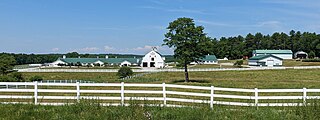
Pineland Farms is a 5,000-acre farm and recreational property in the eastern part of New Gloucester, Maine. It is partly on the site of the former Pineland Hospital and Training Center.

Agnews Developmental Center were two psychiatric and medical care facilities, located in Santa Clara, California and San Jose, California respectively.

Rancho Los Amigos National Rehabilitation Center is a rehabilitation hospital located in Downey, California, United States. Its name in Spanish means "Friends' Ranch".

Grafton State Hospital was a psychiatric hospital in Grafton, Massachusetts that operated from 1901 to 1973. Today, the site has been redeveloped with Tufts University's Cummings School of Veterinary Medicine as a major occupant, along with the Grafton Job Corps office and various other State agencies.

Broughton Hospital is a psychiatric hospital located in Morganton, North Carolina. It is administered by North Carolina Department of Health and Human Services Division of Mental Health, Developmental Disabilities and Substance Abuse Services.
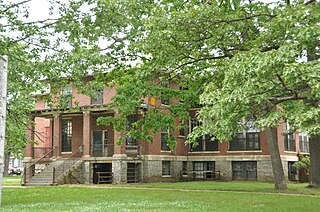
The Wrentham Developmental Center, formerly Wrentham State School, is a historic state-run medical facility for the treatment of psychiatric and developmental disorders. It is located on a large campus at the junction of Emerald and North Streets in Wrentham, Massachusetts. The school was authorized by the state in 1906, and the first phase of the campus was developed between 1909 and 1917. The school opened in 1910. The school had a typical patient population of 1,200-1,300 during the 1920s. The name was changed in the 1990s. The school campus was added to the National Register of Historic Places in 1994.

The Monson Developmental Center was a Massachusetts state facility in Monson, Massachusetts. The property, whose core has been in state control since 1854, historically housed a variety of facilities for providing services to the indigent or sick. It was closed in 2012, and the state is soliciting bids for sale and reuse of the developed portions of the property.
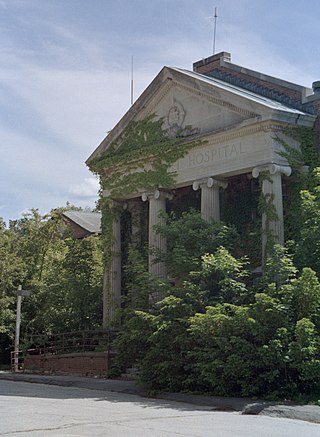
The Mansfield Training School and Hospital was a state school for people with developmental disabilities located in Mansfield, Connecticut, United States. It was active from 1860 to 1993. Its former campus, located at the junction of Connecticut Route 32 and United States Route 44 in Mansfield is a 350-acre (140 ha) historic district that was listed on the National Register of Historic Places in 1987.
The Ladd School in Exeter, Rhode Island operated from 1908 to 1993 as a state institution to serve the needs of people with mental disabilities or developmental delays. It was closed largely due to the deinstitutionalization movement of the 1980s.
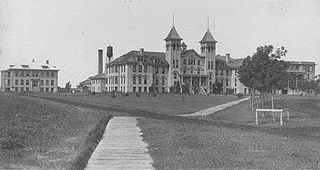
The Grafton State School on 6th St., W., in Grafton, North Dakota was listed on the National Register of Historic Places in 1996.

Mount McGregor is a mountain in Saratoga County, New York in the towns of Wilton, Moreau, and Corinth. It is one of the principal peaks of the Palmertown Range.
The Palmertown range is the most easterly of the five great mountain-chains which traverse the great wilderness. The Palmertown range begins on Lake Champlain, near Ticonderoga, and running down on both sides of Lake George, crosses the Hudson above Glen's Falls, and running through the town of Wilton, ends in the high ground of North Broadway, in Saratoga Springs.

The Northampton Veterans Affairs Medical Center, formerly the Northampton Veterans Administration Hospital, is a facility of the United States Department of Veterans Affairs (VA) at 421 Main Street in the Leeds section of northern Northampton, Massachusetts. Its campus once consisted of about 286 acres (116 ha) of land, which had by 2012 been reduced to 105 acres (42 ha). The hospital was opened in 1924 to treat neuropsychiatric patients, but now provides a wider array of medical services.
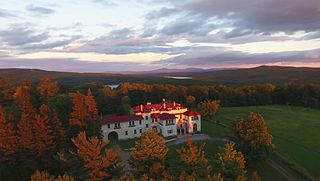
Aldworth Manor, also known as the Arthur E. Childs House, is a historic summer estate house in rural Harrisville, New Hampshire. The house is located at the top of a hill at the end of Aldworth Road, formerly the estate's access drive, and was one of the premiere estate houses of the early 20th century in the town. The house was originally built c.1850 in Worcester, Massachusetts. It was inherited by Arthur E. Childs, a Worcester native from a wealthy family, in the early 20th century.

Spring Hill Farm is a historic farm at 263 Meriden Road in Lebanon, New Hampshire. Founded in the late 18th century, the farm is noted for innovations in dairy farming practices introduced in the 1920s by Maurice Downs. It is also one of a small number of surviving farm properties in the town, and was listed on the National Register of Historic Places in 2002.

The Isaac M. Raymond Farm, now Uphill Farm, is a historic farm property on North Bridgewater Road in Woodstock, Vermont, United States. The farm is the reduced core of a larger farm property accumulated in the first half of the 19th century by Isaac Raymond, and revived as a gentleman's farm in 1940. The property includes an altered 1805 Cape style farmhouse and 20th-century Colonial Revival farm buildings. It was listed on the National Register of Historic Places in 1993.

Saddlebow Farm is a historic farm property at 2477 Gold Coast Road in Bridgewater, Vermont. With a history dating to the 1780s, the property is a fine example of the conversion of agricultural properties to summer and tourist-oriented uses in the 20th century. The 140-acre (57 ha) property was listed on the National Register of Historic Places in 2002.
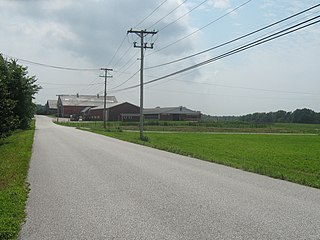
The Ballard Farm is a historic farm property on Ballard Road in Georgia, Vermont. At the time of its listing on the National Register of Historic Places in 1993, it had been under cultivation by members of the Ballard family for more than 200 years, having been established in 1788 by a sale from Ira Allen to Joseph Ballard.

The Malden City Infirmary is a historic municipal facility at 341 Forest Street in Malden, Massachusetts. Established by the city in the 18th century as a poor farm, the surviving elements of the property include the 1870 Warden's House, and the 1933 infirmary, which continues to serve as an elderly care and nursing facility known as Forestdale Senior Living. The property was listed on the National Register of Historic Places in 2020.























